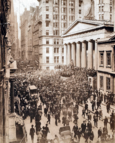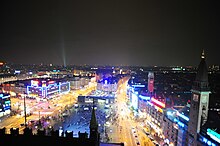The Business and Economics Portal Business is the practice of making one's living or making money by producing or buying and selling products (such as goods and services). It is also "any activity or enterprise entered into for profit." A business entity is not necessarily separate from the owner and the creditors can hold the owner liable for debts the business has acquired. The taxation system for businesses is different from that of the corporates. A business structure does not allow for corporate tax rates. The proprietor is personally taxed on all income from the business. A distinction is made in law and public offices between the term business and a company such as a corporation or cooperative. Colloquially, the terms are used interchangeably. (Full article...) Economics (/ˌɛkəˈnɒmɪks, ˌiːkə-/) is a social science that studies the production, distribution, and consumption of goods and services. Economics focuses on the behaviour and interactions of economic agents and how economies work. Microeconomics analyses what is viewed as basic elements within economies, including individual agents and markets, their interactions, and the outcomes of interactions. Individual agents may include, for example, households, firms, buyers, and sellers. Macroeconomics analyses economies as systems where production, distribution, consumption, savings, and investment expenditure interact, and factors affecting it: factors of production, such as labour, capital, land, and enterprise, inflation, economic growth, and public policies that have impact on these elements. It also seeks to analyse and describe the global economy. (Full article...) Selected articleThe Panic of 1907 was a financial crisis that occurred in the United States when its stock market fell close to 50 percent from its peak the previous year. Primary causes of the run included a retraction of market liquidity by a number of New York City banks, a loss of confidence among depositors, and the absence of a statutory lender of last resort. The crisis occurred after the failure of an attempt in October 1907 to corner the market on stock of the United Copper Company. When this bid failed, banks that had lent money to the cornering scheme suffered runs which later spread to affiliated banks and trusts, leading a week later to the downfall of the Knickerbocker Trust Company—New York City's third-largest trust. The collapse of the Knickerbocker spread fear throughout the city's trusts as regional banks withdrew reserves from New York City banks. The panic would have deepened if not for the intervention of financier J.P. Morgan, who pledged large sums of his own money, and convinced other New York bankers to do the same, to shore up the banking system. By November the contagion had largely ended. The following year, Senator Nelson W. Aldrich established and chaired a commission to investigate the crisis and propose future solutions, leading to the creation of the Federal Reserve System. Selected image
Selected economyThe economy of Denmark is a modern high-income and highly developed mixed economy. The economy of Denmark is dominated by the service sector with 80% of all jobs, whereas about 11% of all employees work in manufacturing and 2% in agriculture. The nominal gross national income per capita was the ninth-highest in the world at $68,827 in 2023. Correcting for purchasing power, per capita income was Int$57,781 or 10th-highest globally. The income distribution is relatively equal but inequality has somewhat increased during the last decades. In 2017, Denmark had the seventh-lowest Gini coefficient (a measure of economic inequality) of the then 28 European Union countries. With 5,932,654 inhabitants (1 January 2023), Denmark has the 38th largest national economy in the world measured by nominal gross domestic product (GDP), and the 52nd largest in the world measured by purchasing power parity (PPP). Among OECD nations, Denmark has a highly efficient and strong social security system; social expenditure stood at roughly 26.2% of GDP. (Full article...) Selected quote"Men who promoted these large corporations were in many cases financiers or merchants, who previously had dealt almost exclusively with money and goods. They had bought in the cheapest markets and sold at the best price they could get. Their natural tendency, therefore, was to apply to the purchase of labor the same rules which they had applied to the purchase of materials, namely, to buy it as cheaply as possible. The great difficulty which stood in the way of accomplishing this result was that there was no exact means of measuring the labor received, and the best that could be done was to buy a man's time, on the theory that time consumed was a measure of labor performed. While this is in a measure correct if the workman feels that he is being equitably rewarded for the work done, it may be far from correct when he does not have this feeling. When he realizes, as is often the case, that the employer, taking advantage of his necessity, gives him the smallest hourly rate he can be hired for, he naturally does only just enough work to hold his job. Moreover, there has seldom been any attempt to keep a record of the work any man did in order that a more equitable compensation might be accorded him; and, whether he did much or little, he was accorded the hourly rate of wages common to his class. The railroad companies, perhaps more than any other organizations, have offended in this manner, and the rates of wages, which they were willing to pay for different classes of workmen were not only fixed by employers, but maintained with all their power. A mechanic, therefore, had but little chance of getting a higher compensation than his class rate, no matter how industrious or conscientious he might be. The introduction of piece work, by which the workman was paid for the work he did, instead of the time he worked, promised better results; but, as piece prices were commonly set on a basis of what had been done by a man dissatisfied with his daily wage, it soon became clear that the men could do much more work than had been done, and earned correspondingly higher wages, with the result that the employer reduced the price per piece. This "cutting" of piece prices was common practice whenever the workman earned much more than his class rate; and the capable workman, recognizing the impossibility of increasing his compensation through more, or better work, soon ceased to make any effort in that direction, and devoted his spare time to the organization of a union with the object of advancing the class rate."
TopicsRelated WikiProjectsDid you know (auto-generated) -
On this day in business history
General imagesThe following are images from various business-related articles on Wikipedia.
More did you know
Business news Wikinews Economy and business portal
|
How Can We Help?










































Recent Comments